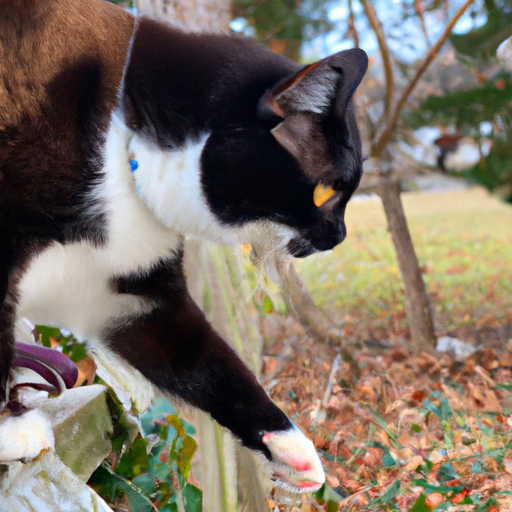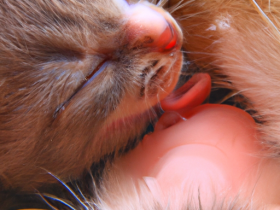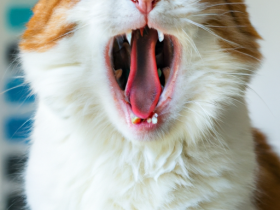“Explore the Wild Side of Cat Ownership – The Pros and Cons of Having an Outdoor Cat!”
Introduction
Having an outdoor cat can be a great way to enjoy the companionship of a pet without having to worry about the mess and expense of an indoor cat. However, there are some potential risks associated with allowing your cat to roam outdoors. In this article, we will discuss the pros and cons of having an outdoor cat so that you can make an informed decision about whether or not it is the right choice for you and your pet.
The Benefits of Having an Outdoor Cat: What Are the Advantages?
Having an outdoor cat can be a rewarding experience for both the pet and its owner. Outdoor cats are able to explore their environment, exercise, and socialize with other cats. While there are some risks associated with allowing a cat to roam outdoors, there are also many advantages.
One of the primary benefits of having an outdoor cat is that it can provide the pet with an enriched environment. Outdoor cats are able to explore their surroundings, which can help to stimulate their minds and provide them with mental stimulation. Additionally, outdoor cats are able to exercise and engage in activities such as hunting, which can help to keep them physically fit.
Another advantage of having an outdoor cat is that it can help to reduce stress levels. Outdoor cats are able to socialize with other cats, which can help to reduce stress levels and provide them with companionship. Additionally, outdoor cats are able to explore their environment, which can help to reduce boredom and provide them with mental stimulation.
Finally, having an outdoor cat can help to reduce the risk of certain diseases. Outdoor cats are exposed to a variety of different bacteria and viruses, which can help to build up their immune system and reduce the risk of certain diseases. Additionally, outdoor cats are able to hunt and consume prey, which can help to provide them with a balanced diet and reduce the risk of obesity.
Overall, having an outdoor cat can be a rewarding experience for both the pet and its owner. Outdoor cats are able to explore their environment, exercise, and socialize with other cats, which can help to provide them with an enriched environment and reduce stress levels. Additionally, outdoor cats are exposed to a variety of different bacteria and viruses, which can help to build up their immune system and reduce the risk of certain diseases.
The Risks of Having an Outdoor Cat: What Are the Disadvantages?
Outdoor cats can be a source of joy and companionship, but they also come with a number of risks. While cats are naturally curious and independent creatures, allowing them to roam outdoors can put them in danger. Here are some of the potential disadvantages of having an outdoor cat.
1. Predation: Outdoor cats are vulnerable to predation from larger animals such as coyotes, foxes, and hawks. Even if your cat is an experienced hunter, they may not be able to defend themselves against a larger predator.
2. Disease: Outdoor cats are exposed to a variety of diseases, including rabies, feline leukemia, and feline immunodeficiency virus. These diseases can be spread to other cats and even to humans.
3. Injury: Outdoor cats are at risk of being injured by cars, other animals, or even humans. They may also be exposed to toxic substances such as antifreeze or pesticides.
4. Parasites: Outdoor cats are more likely to be infested with fleas, ticks, and other parasites. These parasites can cause skin irritation and other health problems.
5. Stress: Outdoor cats are exposed to a variety of environmental stressors, such as loud noises, unfamiliar animals, and changes in temperature. This can lead to increased stress levels and behavioral problems.
Overall, while outdoor cats can be a source of joy and companionship, they also come with a number of risks. It is important to weigh the potential risks and benefits before allowing your cat to roam outdoors.
How to Keep Your Outdoor Cat Safe and Healthy
Outdoor cats can be a source of joy and companionship, but they also require special care to ensure their safety and health. Here are some tips to help keep your outdoor cat safe and healthy.
1. Provide a safe and secure outdoor space. Make sure your cat has access to a secure outdoor space that is free from predators and other dangers. Install a cat-proof fence or build a catio to keep your cat safe from other animals and cars.
2. Make sure your cat is properly identified. Make sure your cat is wearing a collar with an identification tag that includes your contact information. This will help ensure that your cat can be returned to you if it gets lost.
3. Provide regular veterinary care. Make sure your cat is up-to-date on its vaccinations and has regular check-ups with a veterinarian. This will help ensure that your cat is healthy and free from parasites and other illnesses.
4. Feed your cat a balanced diet. Provide your cat with a balanced diet that includes high-quality wet and dry food. Make sure to provide plenty of fresh water and avoid feeding your cat table scraps.
5. Monitor your cat’s activity. Make sure to monitor your cat’s activity and behavior to ensure that it is not getting into any trouble or getting hurt.
By following these tips, you can help ensure that your outdoor cat is safe and healthy. With proper care and attention, your cat can enjoy a long and happy life.
The Pros and Cons of Declawing an Outdoor Cat
Declawing an outdoor cat is a controversial topic that has been debated for many years. On one hand, some people believe that declawing is a necessary procedure to protect furniture and other items from being scratched. On the other hand, some people believe that declawing is an inhumane and cruel practice that should be avoided. Before making a decision about declawing an outdoor cat, it is important to consider both the pros and cons.
Pros
One of the main advantages of declawing an outdoor cat is that it can help protect furniture and other items from being scratched. Cats have a natural instinct to scratch, and this can cause significant damage to furniture and other items. Declawing can help reduce the amount of damage caused by scratching.
Another advantage of declawing an outdoor cat is that it can help reduce the risk of injury to other animals. Cats with claws can cause serious injury to other animals, such as birds and small mammals. Declawing can help reduce the risk of injury to other animals.
Cons
One of the main disadvantages of declawing an outdoor cat is that it can be a painful and traumatic experience for the cat. Declawing involves the removal of the cat’s claws, which can be a painful and traumatic experience for the cat.
Another disadvantage of declawing an outdoor cat is that it can lead to behavioral problems. Cats rely on their claws for balance and to defend themselves. Declawing can lead to behavioral problems, such as aggression and anxiety.
In conclusion, declawing an outdoor cat is a controversial topic that has been debated for many years. Before making a decision about declawing an outdoor cat, it is important to consider both the pros and cons. While declawing can help protect furniture and other items from being scratched, it can also be a painful and traumatic experience for the cat and can lead to behavioral problems.
How to Create a Safe Outdoor Environment for Your Cat
Creating a safe outdoor environment for your cat is an important part of being a responsible pet owner. Cats are naturally curious and love to explore, so it is important to ensure that they have a safe and secure area to do so. Here are some tips to help you create a safe outdoor environment for your cat.
First, make sure that your cat is properly identified. This can be done by having your cat microchipped or wearing a collar with an identification tag. This will help ensure that your cat can be returned to you if it gets lost.
Second, provide your cat with a secure outdoor enclosure. This can be a cat run or a catio, which is an enclosed outdoor space for cats. Make sure that the enclosure is escape-proof and that it is large enough for your cat to move around and explore.
Third, provide your cat with plenty of toys and activities to keep them entertained. This will help keep them from getting bored and potentially getting into trouble.
Fourth, make sure that your cat is up-to-date on all of its vaccinations. This will help protect your cat from any potential illnesses or diseases that it may come into contact with while outdoors.
Finally, be aware of any potential hazards in your outdoor environment. Make sure that your cat is not exposed to any toxic plants or chemicals, and that there are no potential predators in the area.
By following these tips, you can help ensure that your cat has a safe and secure outdoor environment to explore and enjoy.
Q&A
1. What are the pros of having an outdoor cat?
A. The pros of having an outdoor cat include providing your cat with a stimulating environment, allowing them to explore and hunt, and providing them with exercise and mental stimulation. Outdoor cats also have the opportunity to socialize with other cats and animals, and can help to keep pests away from your home.
2. What are the cons of having an outdoor cat?
A. The cons of having an outdoor cat include the risk of them being exposed to diseases, parasites, and predators. Outdoor cats are also more likely to get into fights with other cats, and can be injured or killed in traffic. Additionally, outdoor cats can be a nuisance to neighbors, and can cause damage to property.
3. How can I keep my outdoor cat safe?
A. To keep your outdoor cat safe, make sure they are spayed or neutered to reduce the risk of them getting into fights with other cats. Additionally, provide them with a safe and secure outdoor enclosure, and make sure they are up to date on their vaccinations.
4. What should I do if my outdoor cat gets lost?
A. If your outdoor cat gets lost, contact your local animal shelter or humane society to see if they have any information on your cat. Additionally, post flyers in your neighborhood and check online lost and found pet websites.
5. Are there any alternatives to having an outdoor cat?
A. Yes, there are alternatives to having an outdoor cat. You can provide your cat with a stimulating indoor environment by providing them with plenty of toys, scratching posts, and places to hide. Additionally, you can take your cat for supervised walks on a leash or harness.
Conclusion
In conclusion, the pros and cons of having an outdoor cat should be carefully considered before making a decision. While outdoor cats can provide companionship and entertainment, they can also be a source of stress and potential danger. It is important to weigh the risks and benefits of having an outdoor cat before making a decision. Ultimately, the decision should be based on the individual needs and preferences of the cat owner.








Leave a Reply
View Comments